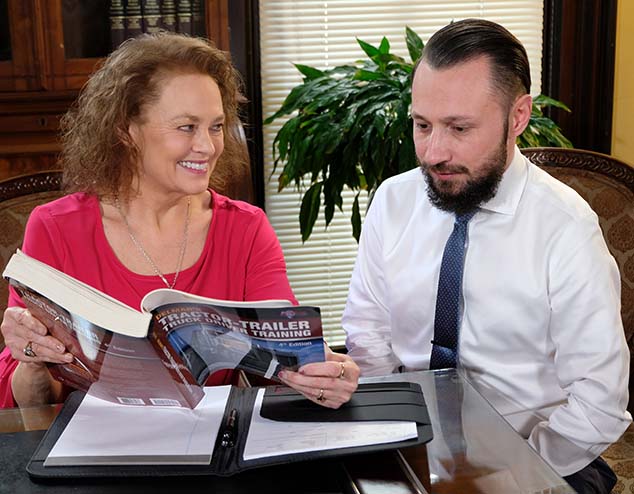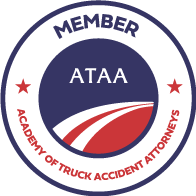- Nationally Recognized
- Voted Best in Bowling Green
- Our Fee is Free, Only Pay If We Win
- We've Won Millions

Semi-Truck Accidents Caused by Truck Blind Spots and Lane Changes
Trucks have a lot of mirrors. That does not mean that the driver used them correctly. This situation is what happened in the case below. The car was traveling when struck on the side by a semi-truck. The semi-truck driver failed to see the car and pushed the car against the retaining wall. Truck drivers should know the dangers of a truck blind spot. A truck driver is trained from the beginning about managing space 360 degrees around the truck where Flora Templeton Stuart Accident Injury Lawyers collected damages for a young woman crushed in her car in a semi-truck accident.
Trucks have a lot of mirrors. That does not mean that the driver used them correctly. This situation is what happened in the case below. The car was traveling when struck on the side by a semi-truck. The semi-truck driver failed to see the car and pushed the car against the retaining wall. Truck drivers should know the dangers of a truck blind spot. A truck driver is trained from the beginning about managing space 360 degrees around the truck where Flora Templeton Stuart Accident Injury Lawyers collected damages for a young woman crushed in her car in a semi-truck accident.
Avoiding Accidents in Semi-Trucks
To be a safe driver, a trucker has to know what is going around all around his vehicle. Not looking properly is a major cause of accidents involving a truck blind spot. Because stopping or changing lanes can take a lot of distance, knowing what the traffic is doing on all sides of the truck is very important. A trucker must look well ahead to make sure that there is enough room to make these moves safely.
A good truck operator will look at least 12 to 15 seconds ahead. That means looking ahead a distance that the truck will travel in 12-15 seconds. Allow for lots of room when driving around a truck. The hood of a semi hides part of the road from the truck driver.
To Stay Safe:
- Use your signal.
- Pass quickly, but legally, to avoid the truck’s blind spots.
- If you cannot pass a truck, allow your car to fall back so that you can be seen again.
Lane changes that result in a big truck striking a smaller vehicle can occur due to a truck blind spot which can be caused by bad weather.
At night a driver can only see as far as the illumination cast by the truck’s headlights. Consequently, a trucker driving at night must drive slowly enough to stop within the distance of the headlights. Driving any faster is referred to as “OVER DRIVING” the headlights. This is a potentially dangerous practice as, by the time the truck operator sees a hazard, the object will be closer than the distance the driver will need to come to a complete stop.
- Perception distance: This is the distance the vehicle travels from the time the driver’s eyes sees the hazard until the brain recognizes it. The perception time for an alert driver is about 3/4 of a second. At 55 MPH a truck will travel 60 feet in 3/4 of a second.
- Reaction distance: The distance the truck will travel from the time the driver’s brain tells the driver to take his foot off the accelerator until the foot id actually pushing the brake pedal. The average driver has a reaction time of 3/4 of a second. At 55 MPH the truck, therefore, will travel an additional 60 feet for a total of 120 feet.
- Braking distance: The distance it takes to stop once the brakes are put on. At 55 MPH on dry pavement with good brakes, it can take a heavy vehicle about 390 feet to stop. It takes about 4 seconds.
- Total stopping distance: At 55 MPH it will take about 6 seconds to stop a truck and the truck will have traveled about 512 feet.
As a general rule, on low-beam, a tractor-trailer’s headlights will illuminate about 250 feet in front of the vehicle. High beams will illuminate for approximately 350-500 feet. This is subject, of course, to whether the lights were properly working, adjusted properly and FREE of road debris, mud, and dirt.
Approximately 500,000 truck accidents occur in the United States every year, of which 5,000 (or 1 in 8) are fatal. A truck is defined as a large trailer weighing 10,000 or more pounds.
Tractor-Trailer crashes are almost always more serious than collisions involving two automobiles. Semi-trucks are simply bigger and faster than cars. According to the Insurance Institute for Highway Safety (IIHS), tractor-trailers weigh 20 to 30 times more than an average car. They also take between 20 to 40 percent more distance than cars to fully stop.
When semi-truck crashes happen, they have high fatality rates. In most cases, the fatalities are drivers and passengers in standard vehicles. Of the more than 3,600 fatal large truck crashes in 2013, 67 percent of the deaths were car occupants and passengers. Simply put, cars are no match for semi-trucks.
A semi-truck has multiple blind spots that every driver on the road should be aware of, including:
- Behind the trailer. If you are following a large truck, you should allow a large gap between yourself and the back of the trailer. Semis do not have
rear-view mirrors like passenger vehicles do, so if you cannot see the mirrors on the sides of the cab, the driver simply cannot see you, sometimes as far back as 200 feet—or even more. Though all trailers are required by law to have rear underride guards in case of rear-end accidents, a collision with a fully-loaded tractor-trailer can still be devastating. - On either side of the trailer. Most trucks have truck blind spots on the left, but the right blind spot is particularly dangerous. It usually runs the full length of the trailer and the cab as well. The right blind spot can extend out as far as three lanes, making passing on the right a particularly dangerous situation. Trucks also require extra space on the right when making a right-hand turn. It is always best to avoid passing or even driving to the right of a truck.
- In front of the cab. The driver’s cabin of a semi is very high off the ground. Given most engine-forward tractor designs, there is a significant area directly in front of a truck where any hazards, including smaller vehicles, are blocked by the engine compartment—and are completely invisible to the driver.
LEGAL LIABILITY IN TRUCK BLIND SPOT ACCIDENTS
When getting licensed to drive a semi-truck, drivers are supposed to receive special training to account for the truck blind spots and operate safely. If the driver ignored this training and operated the truck in an unsafe, reckless, or otherwise careless manner, they may be found liable for the resulting accident. Fatigue, haste to make shipping deadlines, or just plain carelessness on the road can cause drivers to make a mistake that can cost you dearly.
Kentucky & Tennessee Personal Injury Lawyer Flora Templeton Stuart have represented hundreds of clients injured by big trucks. We understand the complexities of these types of cases and will go after all the parties who are responsible for your damages. Call our law firm at (888) 782-9090 twenty-four hours a day, seven days a week so our team of experienced lawyers can be on the scene to preserve the evidence
You Have Questions – We Have Answers
If you or a loved one has been injured, don’t wait. Contact an experienced trucking accident lawyer immediately. When we receive a call from a client who has been injured, we go to work immediately to protect their rights to full and fair compensation.






